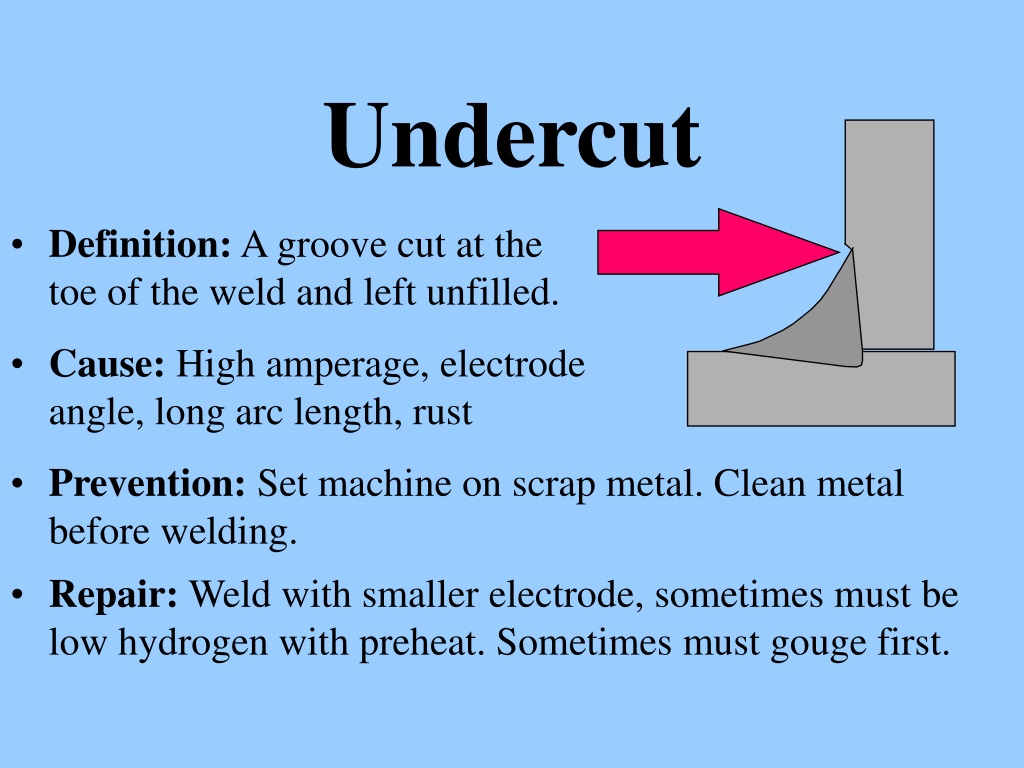Best Practices for Preventing Weld Undercut: Understanding the Basics
Best Practices for Preventing Weld Undercut: Understanding the Basics
Blog Article
Comprehending the Causes and Solutions for Undercut Welding in Metal Fabrication Procedures
In the realm of steel manufacture procedures, the occurrence of undercut welding positions a significant obstacle that demands an extensive understanding of its causes and practical remedies. The elaborate interplay of different factors during welding operations can cause this unwanted phenomenon, affecting the structural honesty and general quality of the bonded joints - Preventing weld undercut. By exploring the source of undercut welding and discovering efficient remedial actions, producers can elevate the standard of their craftsmanship and make certain the production of flawless steel elements
Common Reasons For Undercut Welding
Often neglected in steel construction, undercut welding occurs due to numerous elements that demand precise attention and proficiency to be efficiently reduced. Furthermore, inappropriate welding methods, such as utilizing the incorrect welding angle or take a trip rate, can additionally add to damage development. The selection of welding specifications, such as voltage, current, and wire feed speed, plays a considerable function in the incident of undercut welding.
Effect of Incorrect Welding Parameters
Imprecise welding specifications can significantly compromise the integrity and quality of bonded joints in steel fabrication procedures. The impact of incorrect welding parameters shows up in various means, resulting in structural weaknesses and defects in the bonded parts. One important aspect affected by incorrect welding parameters is the infiltration deepness of the weld. Inadequate warmth input due to low welding currents or exceedingly high travel rates can result in inadequate combination in between the base steels, leading to incomplete joint penetration and deteriorated bonds. Conversely, excessive warm input triggered by high welding currents or slow traveling speeds can lead to burn-through and too much support, developing a brittle and unstable weld structure. Additionally, incorrect criteria such as incorrect voltage settings or wrong electrode angles can contribute to erratic weld bead accounts, absence of combination, and enhanced possibilities of issues like undercutting. Consequently, precise attention to welding criteria is paramount to make certain the manufacturing of top notch welds with the desired mechanical buildings and structural integrity.
Effect of Improper Lantern Angle
Improper torch angle in welding operations can dramatically impact the high quality and integrity of the last weld joints in steel manufacture processes. The torch angle plays a crucial function in identifying the warmth input and distribution during welding. When the lantern angle is incorrect, issues such as damaging can develop. Undercutting is an usual welding issue where a groove develops along the weld toe, compromising the joint and endangering its architectural integrity.
A torch angle that is as well high can result in not enough infiltration, insufficient blend, and increased spatter. On the various other hand, a lantern angle that is too shallow can lead to extreme infiltration, burn-through, and distortion of the base material. Preventing weld undercut. Appropriate lantern angle is necessary for making sure constant weld quality, strength, and appearance
To avoid undercutting and other problems triggered by inappropriate torch angles, welders should be trained to maintain the appropriate torch angle throughout the welding process. Routine surveillance and adjustment of lantern angles during welding can aid achieve sound welds with marginal flaws.
Duty of Inadequate Welding Strategies

One more aspect of insufficient welding strategies is improper weld preparation. Insufficient cleansing of the base metals, inaccurate joint design, or insufficient side preparation can all add to undercut welding. Insufficient protecting gas coverage or making use of the incorrect type of gas can result in insufficient blend and the development of undercut flaws.
To address the role of inadequate welding strategies in metal construction processes, it is crucial to supply comprehensive training for welders. Proper education and learning on welding specifications, joint preparation, and protecting gas selection can help avoid undercut welding and make certain high-grade welds in metal construction jobs.
Effective Solutions for Undercut Welding
Addressing undercut welding in steel fabrication requires implementing reliable solutions to enhance weld top quality and structural honesty. Among the primary options to fight undercut is to readjust welding criteria such as voltage, current, and travel speed to ensure correct heat input and combination. By fine-tuning these settings, welders can avoid too much melting of the base metal and filler material, lowering the likelihood of undercut development.
Furthermore, proper joint prep work is vital in stopping undercut. Making certain clean base metal surfaces devoid of impurities and using the ideal bevel angle can assist promote better weld infiltration and minimize the threat of undercut - Preventing weld undercut. Utilizing ideal welding methods, such as weaving or oscillating the lantern, can additionally help in distributing warm uniformly and loading the weld joint effectively, minimizing the opportunity of undercut flaws
In addition, choosing the correct welding consumables, consisting of electrodes and filler metals, is essential in minimizing undercut. Making click this use of materials with appropriate chemical make-ups and mechanical homes can add to accomplishing sound welds with minimal undercut. Regular evaluation and quality control actions should likewise be executed to discover and deal with undercut concerns promptly, ensuring the general stability of fabricated metal components.

Verdict
Finally, comprehending the reasons and options for undercut welding in steel construction procedures is essential for achieving high-grade welds. By dealing with typical reasons such as inaccurate welding criteria, incorrect lantern angle, and poor welding methods, welders can prevent undercutting and make sure solid, long lasting welds. It is necessary to focus on these aspects and carry out reliable solutions to boost the overall welding procedure and end product high quality.

Report this page